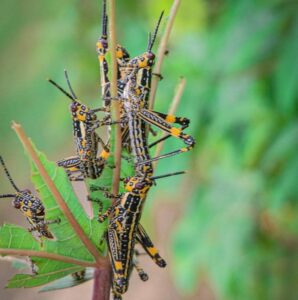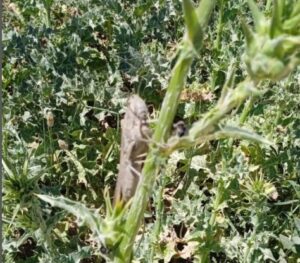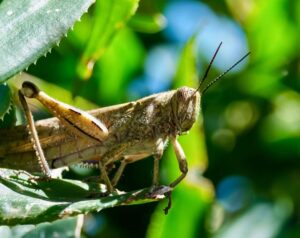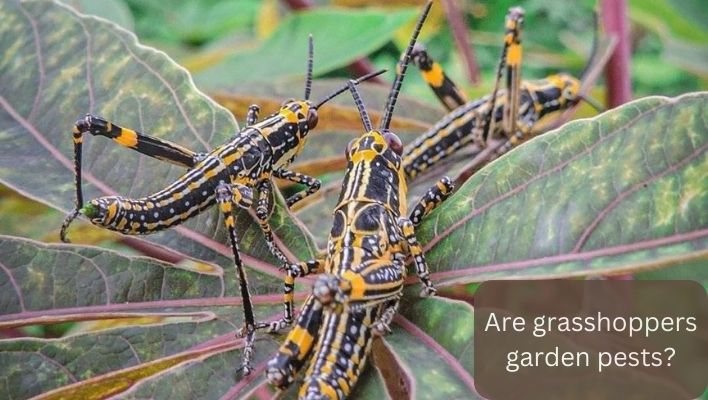Are you an avid gardener who loves spending time outdoors, tending to your plants and flowers? If so, you know how much effort it takes to maintain a healthy and thriving garden.
As the sun shines down on your garden, you take a deep breath and admire your beautiful plants. You’ve put in hours of work to create this serene environment, but suddenly you notice something strange.
Your plants seem to be disappearing, and upon closer inspection, you realize that they are being eaten by a swarm of grasshoppers.
One of the biggest challenges gardeners face is dealing with pests that can damage and destroy their hard work. One such pest is the grasshopper, a common insect that can wreak havoc on gardens. These seemingly harmless insects can wreak havoc on your garden if left unchecked. But are grasshoppers garden pests?
we’ll explore everything you need to know about grasshoppers and their impact on gardens. From identifying them to preventing and controlling their invasion, we’ll provide you with all the information you need to protect your garden from these pesky critters.
Are Grasshoppers Garden Pests?
Are grasshoppers garden pests? Let’s take a closer look at what makes these insects a potential threat to your garden.
Identification of grasshoppers:
Before we can answer the question of whether or not grasshoppers are garden pests, we need to know how to identify them. Grasshoppers are insects that belong to the family Acrididae/ suborder Caelifera.
They are typically brown or green and have long hind legs that allow them to jump great distances. They also have large wings that enable them to fly, although they are not very good at it. One of the most distinctive features of grasshoppers is their large eyes, which give them excellent vision.

Types of grasshoppers found in gardens:
There are many different species of grasshoppers, but the ones that are most commonly found in gardens include the differential grasshopper, the two-striped grasshopper, and the red-legged grasshopper.
These species are known for their voracious appetites and can quickly strip a garden of its foliage. These grasshoppers are usually brown, green, or yellow and can be anywhere from 1 to 4 inches long.
Damage caused by grasshoppers to gardens:
Grasshoppers feed on a variety of plants, including fruits, vegetables, and ornamental plants. They have a particular fondness for young, tender plants, which they can quickly devour.
Grasshoppers use their strong mandibles to chew through leaves and stems, leaving behind ragged edges and holes. In severe infestations, grasshoppers can completely defoliate a plant, stunting its growth and reducing its yield. Now, onto the main question are grasshoppers garden pests?
Are grasshoppers garden pests?
The answer is yes. Grasshoppers can cause a lot of damage to gardens. They feed on the leaves, stems, and flowers of plants, and can quickly strip a plant of its foliage. They can cause significant damage to your plants and can quickly decimate your garden if left unchecked.
This can stunt the growth of the plant and even kill it. Grasshoppers are especially damaging to young plants, which can’t handle as much feeding damage as mature plants.

Signs of grasshopper infestation in gardens:
- One of the most obvious signs of a grasshopper infestation is the presence of the insects themselves. Grasshoppers are most active during the day and can often be seen jumping or flying through the garden.
- Another telltale sign is damage to plants, including holes in leaves and stems missing foliage, and wilted or stunted growth. If you suspect a grasshopper infestation, you can also look for the insects’ eggs, which are laid in the soil.
Comparison of grasshoppers with other garden pests:
While grasshoppers are certainly a nuisance for gardeners, they are not the only pests that can cause damage to plants. Other common garden pests include aphids, caterpillars, and slugs. Each of these pests has its unique feeding habits and methods of attack.
For example, aphids feed on plant sap, while caterpillars chew through leaves. Slugs, on the other hand, leave behind a trail of slime as they munch their way through the garden.
Compared to these other pests, grasshoppers are more indiscriminate in their feeding habits and can cause widespread damage to a variety of plants. While these pests may cause different types of damage, grasshoppers are particularly destructive due to their voracious feeding habits and ability to jump from plant to plant.
Why Grasshoppers Invade Gardens
Grasshoppers are known to invade gardens for several reasons.
- One of the main reasons is that gardens provide a diverse range of plants that serve as a food source for grasshoppers.
- Additionally, gardens tend to have less competition for resources than natural habitats, making them an attractive option for grasshoppers looking for food and shelter.
There are several factors that can attract grasshoppers to gardens. One of the biggest attractants is moisture. Grasshoppers are attracted to moist environments, so gardens that are well-watered or have a lot of dew or rain are more likely to attract grasshoppers, also the presence of other insects is another factor that attracts this voracious eater.
Additionally, gardens that are surrounded by grassy areas or fields may be more attractive to grasshoppers, as these areas provide natural habitats for them.

Impact of weather and environmental factors on grasshopper invasion:
Weather and environmental factors can also have a big impact on grasshopper invasion. Hot, dry weather can cause grasshoppers to migrate in search of food and water, which can lead them to gardens.
Similarly, if there is a drought or a shortage of food in their natural habitats, grasshoppers may turn to gardens as a food source.
The economic and ecological significance of grasshopper damage:
The economic and ecological significance of grasshopper damage is not to be underestimated. In agricultural areas, grasshopper infestations can lead to significant crop damage and economic losses for farmers. Additionally, grasshopper feeding can have a cascading effect on ecosystems, leading to a reduction in plant and animal populations.
The damage caused by grasshoppers can have significant economic and ecological impacts. In agricultural areas, grasshopper infestations can lead to significant crop losses and decreased yields, which can have a ripple effect on the economy. Additionally, grasshopper damage can disrupt the delicate ecological balance of an ecosystem, as it can affect the food chain and the natural habitats of other animals.
There are several reasons why grasshoppers invade gardens, including food availability and environmental factors. While gardens may be attractive to grasshoppers, their presence can have a significant impact on the health and well-being of garden plants. It’s important to monitor your garden regularly and take steps to control grasshopper infestations to minimize damage and promote a thriving garden.
How to identify grasshopper damage in your garden
If you suspect that your garden has a grasshopper infestation, it’s important to know how to identify grasshopper damage. Here are some signs to look out for:
Signs of grasshopper presence in your garden:
- Chewing marks on leaves stems, and flowers
- Irregular holes or notches in leaves
- Stripped leaves or stems
- Young plants that have been completely eaten
- Grasshopper droppings, which resemble small, dark pellets
One of the most obvious signs of grasshopper presence in your garden is the appearance of holes in leaves, stems, and flowers of plants. Grasshoppers feed on the foliage of plants, leaving behind a distinctive pattern of holes and ragged edges.
Additionally, grasshoppers may leave behind droppings on plants or the ground around them, which can also be a sign of their presence.

Types of plants that are most susceptible to grasshopper damage:
While grasshoppers can feed on a variety of plant species, certain plants are more susceptible to damage. These include vegetables like lettuce, broccoli, and spinach, as well as ornamental flowers like marigolds and petunias.
Also, plants with soft foliage and stems, such as young seedlings and flowering plants, are more likely to be targeted by grasshoppers. Additionally, plants that are already stressed due to poor soil conditions, lack of water, or disease may be more vulnerable to grasshopper damage.
Tips for early detection and prevention
Early detection is key when it comes to preventing and controlling grasshopper infestations in your garden. Here are some tips to help you identify and prevent grasshopper damage:
- Regularly inspect your garden for signs of grasshopper activity.
- Use sticky traps to capture grasshoppers and monitor their presence in your garden.
- Remove grasshopper eggs from your garden in the early spring, before they hatch.
- Encourage natural predators like birds and praying mantises to take up residence in your garden.
- Consider using organic pest control methods like neem oil or insecticidal soap to control grasshopper populations.
Regularly inspect your plants for signs of damage and keep an eye out for grasshoppers themselves. You can also set up traps or barriers around your garden to prevent grasshoppers from entering or trap them before they can cause damage.
Additionally, creating a diverse and balanced ecosystem in your garden, with a variety of plant species and natural predators of grasshoppers, can help deter them from invading in the first place.
In conclusion, identifying and preventing grasshopper damage in your garden requires careful observation and proactive measures. By staying vigilant and taking steps to deter grasshoppers, you can protect your plants and promote a healthy and thriving garden.
Methods for controlling grasshoppers in your garden
Controlling grasshoppers in your garden can be a challenging task, but there are several methods that can be used to effectively manage and prevent damage. Here are some common methods for controlling grasshoppers in your garden:
Physical barriers:
One effective way to control grasshoppers in your garden is to use physical barriers such as mesh netting or row covers to prevent them from accessing your plants. This is particularly useful for protecting young plants, which are more susceptible to damage.
Cultural control:
Cultural control involves altering the conditions in your garden to make it less attractive to grasshoppers. This can include practices like crop rotation, which helps to reduce the build-up of grasshopper populations by depriving them of their preferred food source.
Additionally, planting a diverse range of plants can help to reduce grasshopper damage by creating a less attractive environment.
Chemical control:
Chemical control methods involve the use of insecticides to kill grasshoppers. However, it’s important to note that this method should only be used as a last resort, as it can be harmful to beneficial insects and other wildlife. When using insecticides, be sure to follow the instructions carefully and use only as directed.
Natural predators:
Encouraging natural predators like birds, lizards, and praying mantises can also be an effective way to control grasshoppers in your garden. By providing nesting boxes or planting trees and shrubs that provide shelter for birds and other wildlife, you can create a welcoming environment for these predators.
Traps:
Traps can also be used to control grasshoppers in your garden. One common method is to use a bucket trap, which involves placing a bucket filled with soapy water in the garden. The grasshoppers are attracted to the water and drown in the bucket.
Companion planting:
Companion planting involves growing certain plants together to create a mutually beneficial relationship. Some plants, such as marigolds and nasturtiums, are known to repel grasshoppers and other pests.
By planting these types of plants alongside your garden vegetables, you can help to deter grasshoppers from damaging your crops.
Manual removal:
If you have a small garden and a manageable number of grasshoppers, you can manually remove them by handpicking them and disposing of them. This method may be time-consuming but can be effective in controlling small populations.
Habitat modification:
Grasshoppers prefer dry and open environments, so modifying the habitat around your garden can help to discourage them from invading. This can include mowing grass and weeds around the garden and removing any piles of debris that may provide shelter for grasshoppers.
Biological control:
Biological control involves the use of natural enemies to control grasshopper populations. One example is the use of microbial insecticides, which contain bacteria that infect and kill grasshoppers. This method is environmentally friendly and has no adverse effects on beneficial insects.
Repellents:
There are several natural repellents available that can help to deter grasshoppers from your garden. These include garlic spray, neem oil, and peppermint oil. These products work by creating an unpleasant smell or taste that grasshoppers will avoid.
Insecticidal soap:
Insecticidal soap is a natural pesticide that can be sprayed directly onto grasshoppers to kill them. It works by disrupting the insect’s cell membranes, causing them to dehydrate and die.
Sticky traps:
Sticky traps are a simple yet effective way to trap grasshoppers. The traps consist of a sticky substance applied to a board or paper. Grasshoppers are attracted to the trap and become stuck when they land on it.
Dusting with diatomaceous earth:
Diatomaceous earth is a natural, powdery substance made from the fossilized remains of diatoms. When applied to plants, it can help to deter grasshoppers and other pests by dehydrating their exoskeletons.
By using a combination of methods listed above, you can effectively manage grasshopper populations in your garden without resorting to harmful chemicals.
Remember to always read labels carefully and follow safety precautions when using any method of controlling grasshoppers in your garden.
Prevention of Grasshopper Infestation in Gardens
Preventing grasshopper infestations in gardens is always better than trying to control them after they have already invaded. Here are some effective methods for preventing grasshopper infestations:
Use physical barriers:
One of the most effective methods of preventing grasshopper infestations is by using physical barriers, such as netting or fencing, to keep them out of your garden. You can also use row covers to protect your plants from grasshopper damage.
Plant-resistant varieties:
Some plant varieties are more resistant to grasshopper damage than others. Research which plant varieties are most resistant to grasshopper damage and choose them for your garden.
Maintain a clean garden:
Keeping your garden clean and free of debris can help to discourage grasshoppers from invading. Remove any piles of brush or debris that can provide hiding places for grasshoppers.
Rotate crops:
Rotating crops is a useful technique for preventing grasshopper infestations. By rotating your crops, you can avoid planting the same crop in the same location year after year, which can attract pests like grasshoppers.
Use companion planting:
As mentioned earlier, certain plants are known to repel grasshoppers. By planting these plants alongside your garden vegetables, you can help to deter grasshoppers from invading.
Practice good garden hygiene:
Practicing good garden hygiene, such as removing dead plant material and controlling weeds, can help to prevent grasshopper infestations. Grasshoppers are attracted to weedy areas, so keeping your garden weed-free can make it less attractive to them.
Use insecticidal soap:
Insecticidal soap can be an effective method for controlling grasshoppers in your garden. The soap works by suffocating the insects, so it’s important to apply it directly to the grasshoppers.

Apply diatomaceous earth:
Diatomaceous earth is a natural powder that is made up of the fossilized remains of small organisms called diatoms. The powder works by cutting into the exoskeleton of the grasshoppers, which causes them to dehydrate and die. It’s important to apply the diatomaceous earth directly to the grasshoppers and around the base of your plants.
Introduce natural predators:
Natural predators, such as birds, rodents, and certain insects, can help to control grasshopper populations in your garden. Consider introducing these predators into your garden to help keep grasshopper populations under control.
Use Sound deterrents:
Some gardeners have had success in deterring grasshoppers by using sound deterrents, such as ultrasonic devices or wind chimes. These devices emit high-pitched noises that are unpleasant to grasshoppers and can discourage them from invading your garden.
Maintain proper irrigation:
Grasshoppers are attracted to areas with abundant moisture, so it’s important to maintain proper irrigation in your garden. Avoid overwatering your plants and make sure to water them at the base, rather than from above, to avoid creating moist areas that are attractive to grasshoppers.
By using a combination of these preventative measures, you can greatly reduce the risk of a grasshopper infestation in your garden.
By using these preventative measures, you can greatly reduce the chances of a grasshopper infestation in your garden.
Are grasshoppers garden pests FAQs
Are grasshoppers harmful to humans?
Grasshoppers are not harmful to humans in the sense that they do not pose any direct danger to our health or safety. However, some people may be allergic to grasshoppers or their droppings, and coming into contact with them can cause skin irritation or respiratory problems.
Additionally, if you plan on consuming plants from your garden that have been affected by grasshopper infestations, you may be consuming pesticides or other harmful substances that were used to control the infestation.
Do grasshoppers only eat specific types of plants?
Grasshoppers are known to feed on a wide variety of plants, including grasses, grains, fruits, and vegetables. However, they tend to prefer certain types of plants over others.
For example, they are particularly fond of corn, beans, lettuce, and other leafy greens. In general, grasshoppers are attracted to plants with tender, succulent foliage.
Can grasshoppers be beneficial to gardens?
While grasshoppers are generally considered to be garden pests, they can also play a beneficial role in some cases. For example, they are an important food source for many animals, such as birds and small mammals.
In addition, some species of grasshoppers are known to feed on the eggs and larvae of other insect pests, which can help to control their populations.
Finally, grasshoppers can contribute to the nutrient cycle in your garden by consuming plant material and excreting nitrogen-rich waste, which can help to fertilize your soil.
However, the benefits of grasshoppers in your garden are generally outweighed by the damage they can cause to your plants, so it’s best to take measures to control their populations if you notice them in your garden.
Conclusion
Grasshoppers can be a significant problem for gardeners, as they can cause extensive damage to a wide range of plants. They are attracted to gardens because of the abundance of tender, succulent foliage, and they can be difficult to control once they have established a presence.
However, by taking proactive steps to prevent infestations and using a combination of physical, cultural, and chemical control methods, you can minimize the impact of grasshoppers on your garden.
By identifying the signs of grasshopper damage early on and implementing appropriate control measures, you can protect your plants and ensure that your garden remains healthy and vibrant throughout the growing season.


